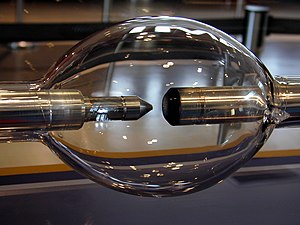


An arc lamp or arc light is a lamp that produces light by an electric arc (also called a voltaic arc).
The carbon arc light, which consists of an arc between carbon electrodes in air, invented by Humphry Davy in the first decade of the 1800s, was the first practical electric light.[1][2] It was widely used starting in the 1870s for street and large building lighting until it was superseded by the incandescent light in the early 20th century.[1] It continued in use in more specialized applications where a high intensity point light source was needed, such as searchlights and movie projectors until after World War II. The carbon arc lamp is now obsolete for most of these purposes, but it is still used as a source of high intensity ultraviolet light.
The term is now used for gas discharge lamps, which produce light by an arc between metal electrodes through a gas in a glass bulb. The common fluorescent lamp is a low-pressure mercury arc lamp.[3] The xenon arc lamp, which produces a high intensity white light, is now used in many of the applications which formerly used the carbon arc, such as movie projectors and searchlights.
- ^ a b Whelan, M. (2013). "Arc Lamps". Resources. Edison Tech Center. Archived from the original on November 10, 2014. Retrieved November 22, 2014.
- ^ Sussman, Herbert L. (2009). Victorian Technology: Invention, Innovation, and the Rise of the Machine. ABC-CLIO. p. 124. ISBN 9780275991692.
- ^ Chen, Kao (1990). "Fluorescent Lamps". Industrial Power Distribution and Illuminating Systems. Electrical Engineering and Electronics. Vol. 65. New York: Dekker. p. 350. ISBN 978-0-8247-8237-5.
The fluorescent lamp is ... activated by ... a low-pressure mercury arc.